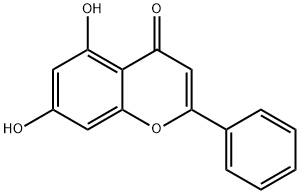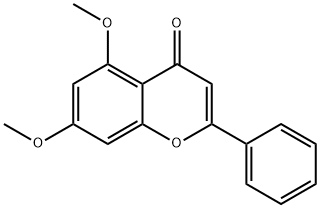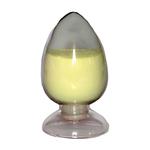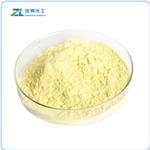Description
Chrysin is a natural flavonoid with antioxidant, anti-inflammatory, and anticancer properties. It blocks COX-2 gene expression, PGE2 production, and hydroxyl radical formation in LPS-induced RAW 264.7 cells. Chrysin inhibits insulin-induced HIF-1α expression (~50% at 10 μM) in human prostate cancer DU145 cells and blocks DU145 xenograft-induced angiogenesis in vivo. In a mouse model of ischemia/reperfusion injury, chrysin decreased pro-inflammatory gene expression and oxidative stress, resulting in a reduction of infarct volume and neurological defects.
Chemical Properties
beige powder or Pale yellow prismatic crystal (crystallized from methanol) with a melting point of 285°C. This substance is soluble in alkali hydroxide solution and acetone, slightly soluble in ether, ethanol and chloroform, insoluble in water.
Uses
Chrysin is a flavanoid with anti-inflammatory effect and potential protective effects against cancer and cardiovascular disease. Studies show that Chrysin is central benzodiazepine receptor ligand with possible anxiolytic effects. Chrysin was initially believed to have aromatase inhibitor but recent in vivo studies have disproved that. Dyes and metabolites.
Definition
ChEBI: Chrysin is a dihydroxyflavone in which the two hydroxy groups are located at positions 5 and 7. It has a role as an anti-inflammatory agent, an antineoplastic agent, an antioxidant, a hepatoprotective agent, an EC 2.7.11.18 (myosin-light-chain kinase) inhibitor and a plant metabolite. It is a dihydroxyflavone and a 7-hydroxyflavonol.
Biological Functions
Chrysin, also referred to as 5,7-dihydroxyflavone, is a naturally occurring antioxidant flavonoi. It holds immense potential for diverse applications and is being investigated as a potential therapeutic agent for various conditions and diseases. Research on chrysin has revealed its antioxidant, anti-inflammatory, anti-cancer, and anti-diabetic properties, along with its ability to modulate the activity of specific enzymes, hormones, and neurotransmitters. Its therapeutic potential extends to areas like oncology, diabetes, and neurological disorders. Although the precise mechanism of action of chrysin is not yet fully comprehended, research suggests its ability to modulate the activity of enzymes, hormones, and neurotransmitters. For instance, it has shown the potential to influence the activity of aromatase, an enzyme involved in estrogen production. Moreover, chrysin has exhibited inhibitory effects on cancer cell growth and inflammation by influencing the activity of specific enzymes and hormones. It was discovered that Chrysin inhibits HIF-1α (hypoxia-inducible factor-1α) and induces apoptosis.
target
NOS | COX | TNF-α | PGE | IL Receptor | PI3K | Akt | Caspase | NF-kB | TGF-β/Smad
Source
The main sources of chrysin are honey and propolis, of which the content of chrysin in honey is 5.3 mg/kg and that in propolis is 28 g/L. In addition, chrysin is also found in various vegetables, fruits, herbs, and even mushrooms. Another source of populin is an endophytic fungus Chaetomium globosum, which is related to Chaetomorpha media from India. In addition, chrysin exists in the form of glycosides in walnut, walnut skin, walnut flower and pericarp passion fruit, and in the form of 6-c-arabinoside-8-c-glucoside or glucuronic acid ester in Pinellia ternata.





